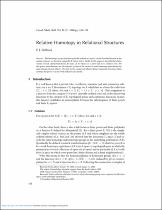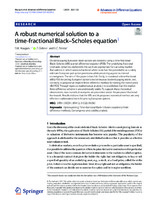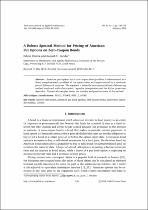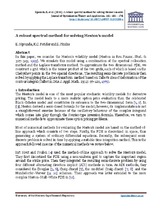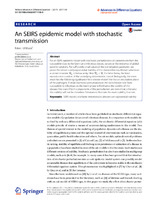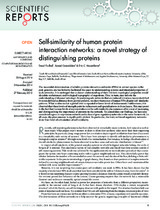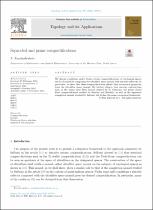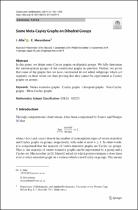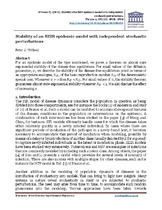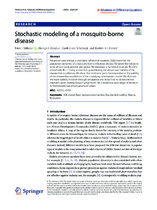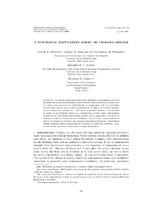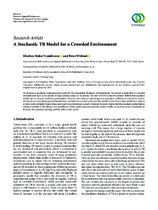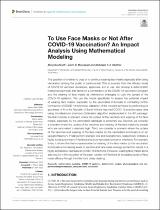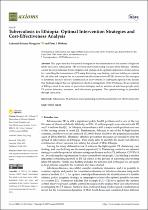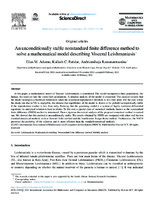Browsing Mathematics by Title
Now showing items 55-70 of 70
-
Relative homotopy in relational structures
(Cambridge University Press, 2018)The homotopy groups of a finite partially ordered set (poset) can be described entirely in the context of posets, as shown in a paper by B. Larose and C. Tardif. In this paper we describe the relative version of such a ... -
A robust numerical solution to a time-fractional Black–Scholes equation
(Springer Nature, 2021)Dividend paying European stock options are modeled using a time-fractional Black–Scholes (tfBS) partial differential equation (PDE). The underlying fractional stochastic dynamics explored in this work are appropriate for ... -
A robust spectral method for pricing of American put options on zero-coupon bonds
(Global-Science Press, 2018)American put options on a zero-coupon bond problem is reformulated as a linear complementarity problem of the option value and approximated by a nonlinear partial differential equation. The equation is solved by an ... -
A robust spectral method for solving Heston’s model
(Springer Verlag, 2014)In this paper, we consider the Heston’s volatility model (Heston in Rev. Financ. Stud. 6: 327–343, 1993]. We simulate this model using a combination of the spectral collocation method and the Laplace transforms method. ... -
An SEIR model with infected immigrants and recovered emigrants
(Springer Science and Business Media Deutschland GmbH, 2021)We present a deterministic SEIR model of the said form. The population in point can be considered as consisting of a local population together with a migrant subpopulation. The migrants come into the local population for ... -
An SEIRS epidemic model with stochastic transmission
(Springer, 2017)For an SEIRS epidemic model with stochastic perturbations on transmission from the susceptible class to the latent and infectious classes, we prove the existence of global positive solutions. For sufficiently small values ... -
Self-similarity of human protein interaction networks: a novel strategy of distinguishing proteins
(2015)The successful determination of reliable protein interaction networks (PINs) in several species in the post-genomic era has hitherto facilitated the quest to understanding systems and structural properties of such networks. ... -
Separated and prime compactifications
(Elsevier BV, 2022)We discuss conditions under which certain compactifications of topological spaces can be obtained by composing the ultrafilter space monad with suitable reflectors. In particular, we show that these compactifications inherit ... -
Some meta-cayley graphs on dihedral groups
(Springer, 2019)In this paper, we define meta-Cayley graphs on dihedral groups. We fully determine the automorphism groups of the constructed graphs in question. Further, we prove that some of the graphs that we have constructed do not ... -
Stability of an SEIR epidemic model with indepenent stochastic perturbations
(Elsevier, 2013)For an epidemic model of the type mentioned, we prove a theorem on almost sure exponential stability of the disease-free equilibrium. For small values of the diffusion parameter, σ, we describe the stability of the disease ... -
Stochastic modeling of a mosquito-borne disease
(Springer Nature, 2020)We present and analyze a stochastic differential equation (SDE) model for the population dynamics of a mosquito-borne infectious disease. We prove the solutions to be almost surely positive and global. We introduce a ... -
A stochastic population model of cholera disease
(American Institute of Mathematical Sciences, 2022-02)A cholera population model with stochastic transmission and stochasticity on the environmental reservoir of the cholera bacteria is presented. It is shown that solutions are well-behaved. In comparison with the underlying ... -
A stochastic TB model for a crowded environment
(Hindawi, 2018)We propose a stochastic compartmental model for the population dynamics of tuberculosis. The model is applicable to crowded environments such as for people in high density camps or in prisons. We start off with a known ... -
To use face masks or not after Covid-19 vaccination? An impact analysis using mathematical modeling
(Frontiers Media, 2022)The question of whether to drop or to continue wearing face masks especially after being vaccinated among the public is controversial. This is sourced from the efficacy levels of COVID-19 vaccines developed, approved, ... -
Tuberculosis in Ethiopia: Optimal intervention strategies and cost-effectiveness analysis
(MDPI, 2022)This paper searches for optimal strategies for the minimization of the number of high-risk latent and active tuberculosis (TB) infectious individuals using real data from Ethiopia. Optimal control theory is harnessed for ... -
An unconditionally stable nonstandard finite difference method to solve a mathematical model describing Visceral Leishmaniasis
(Elsevier, 2021)In this paper, a mathematical model of Visceral Leishmaniasis is considered. The model incorporates three populations, the human, the reservoir and the vector host populations. A detailed analysis of the model is presented. ...

